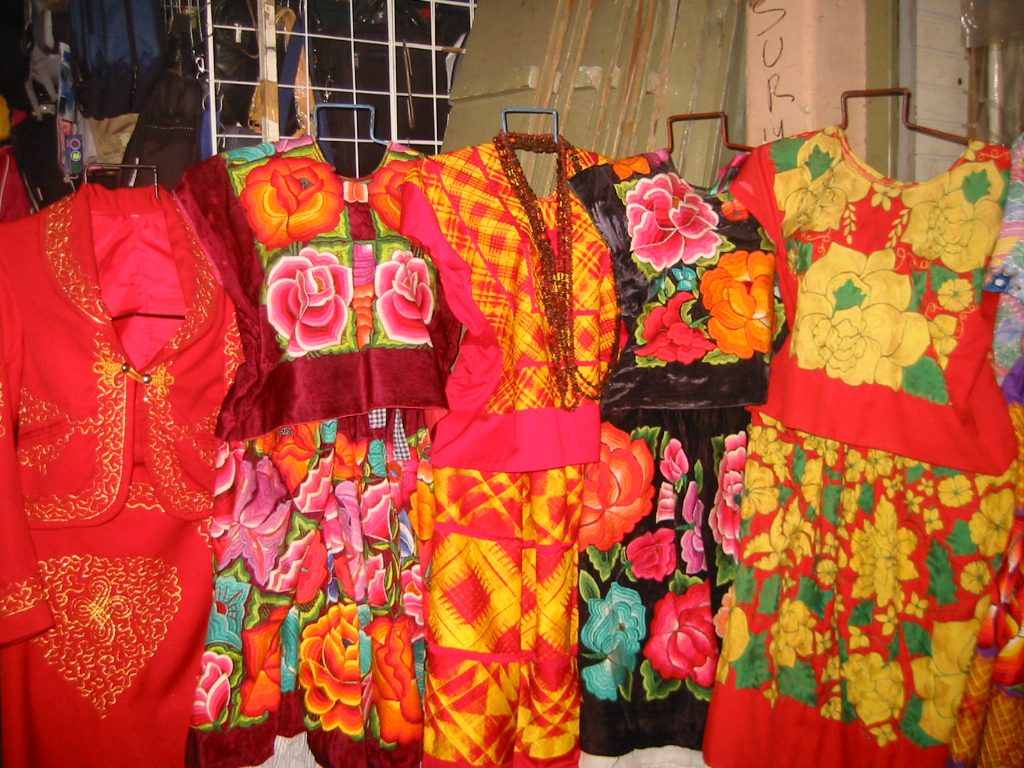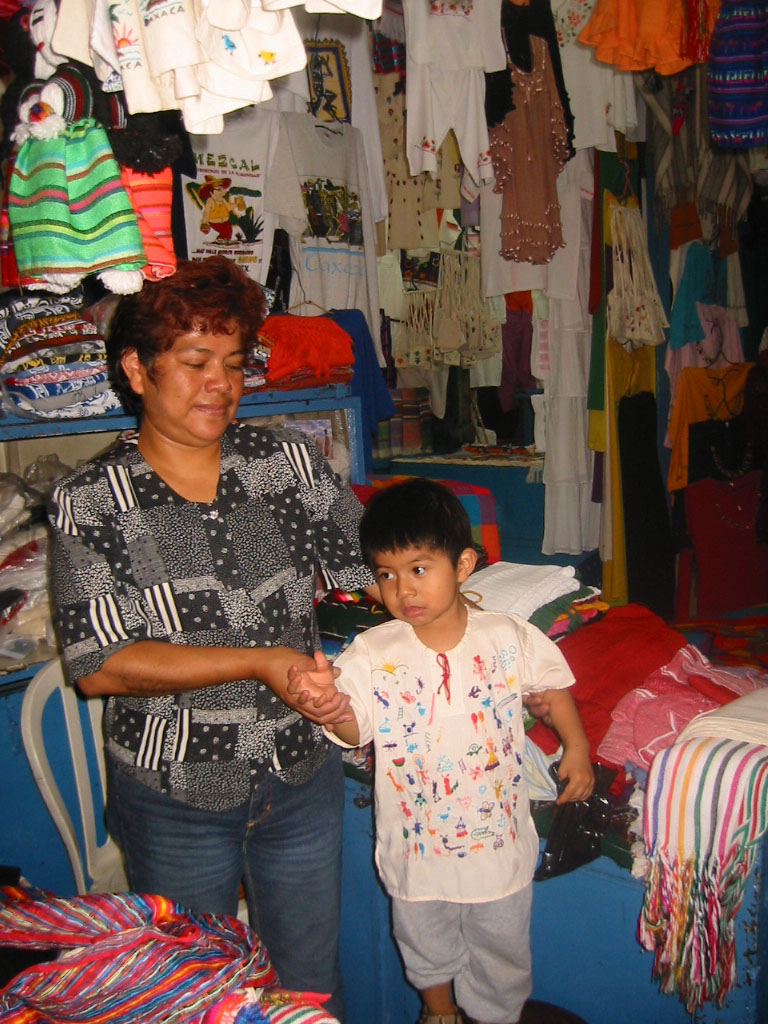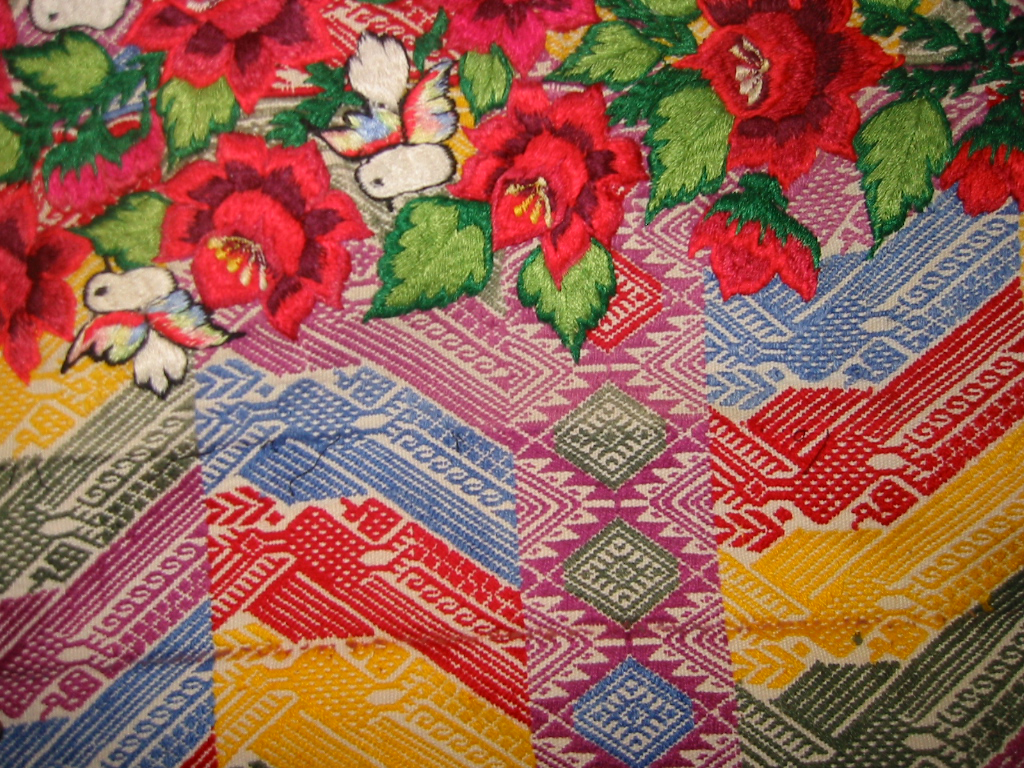 Huipiles, Mexico’s festive native blouses, look good on anyone, from indigenous women to gringas. They come in colors and patterns to suit all personalities and body types, but all share a basic boxy shape. Mexican artisans elevate this simplest of garments to an art form by decorating them with embroidery, ribbons, lace, beadwork, inlay and appliqué.
Huipiles, Mexico’s festive native blouses, look good on anyone, from indigenous women to gringas. They come in colors and patterns to suit all personalities and body types, but all share a basic boxy shape. Mexican artisans elevate this simplest of garments to an art form by decorating them with embroidery, ribbons, lace, beadwork, inlay and appliqué.
Huipiles (from the Nahuatl huipilli) are much more than garments; they are a symbol of Mexico’s cultural diversity.
“For me it means the pride of being from Oaxaca,” says Mirna Juana Gonzalez López, who donned her embroidered huipil to dance in the festival of the Virgin of the Rosary, “It demonstrates happiness; it’s a ritual, an offering to the fiesta.”
Huipiles also tell the history of Mexico’s indigenous peoples and their struggle to adapt while maintaining their cultural identity. The oldest fragments of woven cloth found in Mexico date between 1800 and 1400 BC, but women wearing huipiles appear in murals, carvings, vessels and clay figurines from much earlier periods. The art of weaving was highly valued in Mesoamerica. In Aztec society, cotton huipiles were reserved for nobility, while the commoners were relegated to wearing coarse weaves made from the fibers of the maguey plant. Members of the lower classes could even be put to death for daring to don cotton, the clothing of the Gods. On the contrary, the Lancandon Maya crafted huipil-like tunics from long strips of fig bark, which were soaked in water and then beaten until the fibers joined. To this day, deep in the jungles of Chiapas, some Lancandon shamans wear these tunics to perform pre-Christian rituals.
 The cultural significance of weaving meant that a woman’s status was determined by her skill and productivity in the textile arts. At birth, it was customary to place a spindle and weaving stick in the hands of a female infant, to signify that she would be a good weaver. For Aztec women, it was a great honor to be sacrificed, along with their weaving tools, to the goddess Xochiquetzal, the patroness of handicrafts.
The cultural significance of weaving meant that a woman’s status was determined by her skill and productivity in the textile arts. At birth, it was customary to place a spindle and weaving stick in the hands of a female infant, to signify that she would be a good weaver. For Aztec women, it was a great honor to be sacrificed, along with their weaving tools, to the goddess Xochiquetzal, the patroness of handicrafts.
Traditionally, huipiles are made on a back strap loom. This loom has no stationary framework; rather it consists of two parallel bars, the farthest of which is fastened to a tree or post. The weaver herself is then responsible for holding the warp taught by leaning her weight against a leather strap placed around her lower back. In this way, the woman’s body becomes part of the loom. In parts of Sonora and Chihuahua, instead of the back strap loom, weavers employ square or rectangular looms fashioned from notched logs. These techniques persist in many indigenous communities despite the introduction of the treadle loom by the Spanish in the sixteenth century. Traditional looms produce long strips of fabric (the width is determined by the arm span of the individual weaver). Most huipiles are assembled from two or three such strips, folded lengthwise and stitched up the sides, leaving ample space for the arms. Ribbons, embroidery and other decorations are used to conceal the seams and adorn the arm and neck holes.
In the prehispanic world, textiles served not only as clothing, but as offerings to the Gods, dowry payments, and tributes to heads of state. The Aztec empire, for example, collected approximately two million textiles pieces each year as tribute from the peoples under their rule. In accordance with this tradition, Moctezuma received Hernán Cortés with the gift of textiles. “Considering they were cotton and not silk,” Cortés wrote to the Kind of Spain, “(The textiles) were such that there could not be fashioned or woven anything similar in the whole world for the variety and naturalness of the colors and for the handiwork.”
 The decorations on huipiles are as diverse as the Mexican imagination, but floral, animal and geometric designs are the most common. Many are inspired by prehispanic religious beliefs like the Marigold patterns of the Mixtec and Amuzgo peoples, which represent the souls of the dead. The European influence is reflected by the appearance of Christian symbols like crosses and virgins. While it evolved under European influence, the huipil survived the conquest relatively unchanged because it was principally worn by women. Men mostly adopted European dress because they ventured more frequently from their villages and had more contact with the larger colonial society. So it was the women, with their huipiles, who became the guardians of traditional Mexican dress.
The decorations on huipiles are as diverse as the Mexican imagination, but floral, animal and geometric designs are the most common. Many are inspired by prehispanic religious beliefs like the Marigold patterns of the Mixtec and Amuzgo peoples, which represent the souls of the dead. The European influence is reflected by the appearance of Christian symbols like crosses and virgins. While it evolved under European influence, the huipil survived the conquest relatively unchanged because it was principally worn by women. Men mostly adopted European dress because they ventured more frequently from their villages and had more contact with the larger colonial society. So it was the women, with their huipiles, who became the guardians of traditional Mexican dress.
European techniques such as lace, inlay, and appliqué, came to life in the skillful hands of Mexican women. Probably the best example of this colorful collision of indigenous and European styles is the extravagant huipiles worn by the Zapotec women in the Oaxaca’s Isthmus of Tehuantepec. Thought by many to be inspired by aristocratic costumes salvaged from a wrecked Spanish galleon en route from the Philippines, these huipiles are decadent creations of velvet or satin, with flowers embroidered on a large scale in silk thread.
The Mexican revolution (1910-20) revived the popularity of the huipil on a national level, but in rural communities, especially in the Yucatan Peninsula and southern states like Guerrero, Puebla, Oaxaca and Chiapas, the huipil has been in continuous use since before the Conquest. Even in the cities, you see modern professional women sporting huipiles over skirts, dress pants or jeans.
When you travel to almost any part of Mexico, you’re bombarded by vendors insisting you buy their huipils. Most of these are low quality, machine-made examples. But they are economical and available in a wide array of fun, trendy colors, which makes them popular with Mexicans and tourists alike.
 “You can tell the difference (between a machine and hand made huipil) by looking at the seams,” says Armando Rodriguez, who sells huipiles at his store in Oaxaca’s Benito Juarez Market. He holds up two equally stunning velvet huipiles from the Isthmus of Tehuantepec. I cannot for the life of me guess which is machine made, until he flips up the collars to show me the underside. “A hand- made piece should have threads hanging off,” he explains. “Lots of people don’t appreciate the craftsmanship…They don’t realize these people are embroidering by candlelight out in their pueblos.”
“You can tell the difference (between a machine and hand made huipil) by looking at the seams,” says Armando Rodriguez, who sells huipiles at his store in Oaxaca’s Benito Juarez Market. He holds up two equally stunning velvet huipiles from the Isthmus of Tehuantepec. I cannot for the life of me guess which is machine made, until he flips up the collars to show me the underside. “A hand- made piece should have threads hanging off,” he explains. “Lots of people don’t appreciate the craftsmanship…They don’t realize these people are embroidering by candlelight out in their pueblos.”
 If you’re looking for the “real thing,” you’re in for a lot more work, and a lot more fun. You can travel to the villages and buy directly from the artisans, who may or may not speak Spanish, much less English! But in this case remember you’ll probably only be able to select from the styles produced in that particular region. Or you can visit a specialty store where knowledgeable buyers choose the best pieces from a wide geographic area, like Mujeres Artesanas de Las Regiones de Oaxaca (MARO) in Oaxaca. At MARO you can also be assured that the artisans are receiving their fair share of the profits.
If you’re looking for the “real thing,” you’re in for a lot more work, and a lot more fun. You can travel to the villages and buy directly from the artisans, who may or may not speak Spanish, much less English! But in this case remember you’ll probably only be able to select from the styles produced in that particular region. Or you can visit a specialty store where knowledgeable buyers choose the best pieces from a wide geographic area, like Mujeres Artesanas de Las Regiones de Oaxaca (MARO) in Oaxaca. At MARO you can also be assured that the artisans are receiving their fair share of the profits.
In Zihuatanejo you can find huipiles and a variety of hand crafted regional clothing at Galeria Maya on Nicolas Bravo, and Lupita’s Boutique and the shops of Casa Marina, both on Juan Alvarez.



